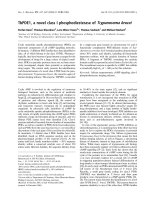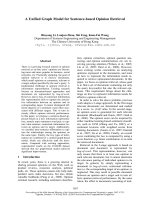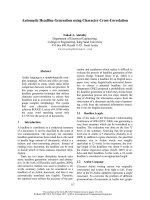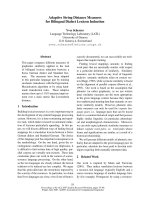Báo cáo khoa học: "Automatic English-Chinese name transliteration for development of multilingual resources" pdf
Bạn đang xem bản rút gọn của tài liệu. Xem và tải ngay bản đầy đủ của tài liệu tại đây (484.46 KB, 5 trang )
Automatic English-Chinese name transliteration for develop-
ment of multilingual resources
Stephen Wan and Cornelia Maria Verspoor
Microsoft Research Institute
Macquarie University
Sydney NSW 2109, Australia
{ swan, kversp } @mri.mq.edu.au
Abstract
In this paper, we describe issues in the translation
of proper names from English to Chinese which
we have faced in constructing a system for multi-
lingual text generation supporting both languages.
We introduce an algorithm for mapping from
English names to Chinese characters based on (1)
heuristics about relationships between English
spelling and pronunciation, and (2) consistent re-
lationships between English phonemes and Chi-
nese characters.
1 Introduction
In the context of multilingual natural language
processing systems which aim for coverage of
both languages using a roman alphabet and lan-
guages using other alphabets, the development of
lexical resources must include mechanisms for
handling words which do not have standard
translations. Words falling into this category are
words which do not have any obvious semantic
content, e.g. most indo-european personal and
place names, and which can therefore not simply
be mapped to translation equivalents.
In this paper, we examine the problem of
generating Chinese characters which correspond
to English personal and place names. Section 2
introduces the basic principles of English-
Chinese transliteration, Section 3 identifies issues
specific to the domain of name transliteration,
and Section 4 introduces a rule-based algorithm
for automatically performing the name translit-
eration. In Section 5 we present an example of
the application of the algorithm, and in Section 6
we discuss extensions to improve the robustness
of the algorithm.
Our need for automatic transliteration
mechanisms stems from a multilingual text gen-
eration system which we are currently construct-
ing, on the basis of an English-language database
containing descriptive information about museum
objects (the POWER system; Verspoor
et al
1998). That database includes fields such as
manufacturer,
with values of personal and place
names. Place names and personal names do not
fall into a well-defined set, nor do they have se-
mantic content which can be expressed in other
languages through words equivalent in meaning.
As more objects are added to our database (as
will happen as a museum acquires new objects),
new names will be introduced, and these must
also be added to the lexica for each language in
the system. We require an automatic procedure
for achieving this, and concentrate here on tech-
niques for the creation of a Chinese lexicon.
2 English-Chinese Transliteration
We use the term
transliteration
to refer generally
to the problem of the identification of a specific
textual form in an output language (in our case
Chinese characters) which corresponds to a
specific textual form in an input language (an
English word or phrase). For words with
semantic content, this process is essentially
equivalent to the
translation
of individual words.
So, the English word "black" is associated with a
concept which is expressed as "~" ([h~i]) in
Chinese. In thiscase, a dictionary search
establishes the input-output correspondence.
For words with little or no semantic content,
such as personal and place names, dictionary
lookup may suffice where standard translations
exist, but in general it cannot be assumed that
names will be included in the bilingual
dictionary. In multilingual systems designed only
for languages sharing the roman alphabet, such
names pose no problem as they can simply be
included unaltered in output texts in any of the
languages. They cannot, however, be included in
a Chinese text, as the roman characters cannot
standardly be realized in the Han character set.
3 Name Transliteration
English-Chinese name transliteration occurs on
the basis of pronunciation. That is, the written
English word is mapped to the written Chinese
character(s) via the spoken form associated with
the word. The idealized process consists of:
1352
1. mapping an English word (grapheme) to a pho-
nemic representation
2. mapping each phoneme composing the word to a
corresponding Chinese character
In practice, this process is not entirely
straightforward. We outline several issues com-
plicating the automation of this process below.
The written form of English is less than
normalized. A particular English grapheme (letter
or letter group) does not always correspond to a
single phoneme (e.g. ea is pronounced differently
in eat, threat, heart, etc.), and many English
multi-letter combinations are realised as a single
phoneme in pronunciation (so f, if, ph, and
gh
can all map to /f/) (van den Bosch 1997). An
important step in grapheme-phoneme conversion
is the segmentation of words into syllables.
However, this process is dependent on factors
such as morphology. The syllabification of
"hothead" divides the letter combination th,
while the same combination corresponds to a
single phoneme in "bother". Automatic
identification of the phonemes in a word is
therefore a difficult problem.
Many approaches exist in the literature to
solving the grapheme-phoneme conversion
problem. Divay and Vitale (1997) review several
of these, and introduce a rule-based approach
(with 1,500 rules for English) which achieved
94.9% accuracy on one corpus and 64.37% on
another. Van den Bosch (1997) evaluates
instance-based learning algorithms and a decision
tree algorithm, finding that the best of these
algorithms can achieve 96.9% accuracy.
Even when a reliable grapheme-to-phoneme
conversion module can be constructed, the
English-Chinese transliteration process is faced
with the task of mapping phonemes in the source
language to counterparts in the target language,
difficult due to phonemic divergence between the
two languages. English permits initial and final
consonant clusters in syllables. Mandarin
Chinese, in contrast, primarily has a consonant-
vowel or consonant-vowel-[nasal consonant (/n/
or /0/)] syllable structure. English consonant
clusters, when pronounced within the Chinese
phonemic system, must either be reduced to a
single phoneme or converted to a consonant-
vowel-consonant-vowel structure by inserting a
vowel between the consonants in the cluster. In
addition to these phonotactic constraints, the
range of Chinese phonemes is not fully
compatible with those of English. For instance,
Mandarin does not use the phoneme Iv/ and so
that phoneme in English words is realized as
either/w/or/f/in the Chinese counterpart.
We focus on the specific problem of country
name transliteration from English into Chinese.
The algorithm does not aim to specify general
grapheme-phoneme conversion for English, but
only for the subset of English words relevant to
place name transliteration. This limited domain
rarely exhibits complex morphology and thus a
robust morphological module is not included. In
addition, foreign language morphemes are treated
superficially. Thus, the algorithm transliterates
the "-istan" (a morpheme having meaning in
Persian) of "Afghanistan" in spite of a standard
transliteration which omits this morpheme.
The transliteration process is intended to be
based purely on phonetic equivalency. On
occasion, country names will have some
additional meaning in English apart from the
referential function, as in "The United States".
Such names are often translated semantically
rather than phonetically in Chinese. However,
this in not uniformly true, for example "'Virgin"
in "British Virgin Islands" is transliterated. We
therefore introduce a dictionary lookup step prior
to commencing transliteration, to identify cases
which have a standard translation.
The transliteration algorithm results in a
string of Han characters, the ideographic script
used for Chinese. While the dialects of Chinese
share the same orthography, they do not share the
same pronunciation. This algorithm is based on
the Mandarin dialect.
Because automation of this algorithm is our
primary goal, the transliteration starts with a
written source and it is assumed that the
orthography represents an assimilated
pronunciation, even though English has borrowed
many country names. This is permitted only
because the mapping from English phonemes to
Chinese phonemes loses a large degree of
variance: English vowel monothongs are
flattened into a fewer number Chinese
monothongs. However, Chinese has a larger set
of diphthongs and triphthongs. This results in
approximating a prototypical vowel by the
closest match within the set of Chinese vowels.
4 An Algorithm for Auto Transliteration
The algorithm begins with a proper noun phrase
(PNP) and returns a transliteration in Chinese
characters. The process involves five main
stages: Semantic Abstraction, Syllabification,
Sub-syllable Divisions, Mapping to Pinyin, and
Mapping to Han Characters.
4.1 Semantic
Abstraction
The PNP may consist of one or more words. If it
is longer than a single word, it is likely that some
part of it may have an existing semantic
translation. "The" and "of' are omitted by
1353
convention. To ensure that such words as
"Unitear" are translated and not transliterated ~, we
pass the entire PNP into a dictionary in search of
a standard translation. If a match is not
immediately successful, we break the PNP into
words and pass each word into the dictionary to
check for a semantic translation 2. This portion of
the algorithm controls which words in the PNP
are translated and which are transliterated.
Search for PNP in dictionary
If exact match exists then
return corresponding characters
else
remove article 'The' and preposition 'of'
For each (remaining) word in PNP
search for word in dictionary
If exact match exists
add matching characters to output string 3
else if the word is not already a chinese word
transliterate the word and add to output string
4.2 Transliteration 1:
Syllabification
Because Chinese characters are monosyllabic,
each word to be transliterated must first be
divided into syllables. The outcome is a list of
syllables, each with at least one vowel part.
We distinguish between a consonant group
and a consonant cluster, where a group is an
arbitrary collection of consonant phonemes and a
cluster is a known collection of consonants. Like
Divay and Vitale (1997), we identify syllable
boundaries on the basis of consonant clusters and
vowels (ignoring morphological considerations).
Any consonant group is divided into two parts,
by identifying the final consonant cluster or lone
consonant in that group and grouping that
consonant (cluster) with the following vowel.
The sub-syllabification algorithm then further
divides each identified syllable. While this
procedure may not always strictly divide a word
into standard syllables, it produces syllables of
the form consonant-vowel, the common
pronunciation of most Chinese characters.
4.2.1 Normalization
Prior to the syllabification process, the input
string must be normalized, so that consonant
I The historical interactions of some European and Asian nations
has lead to names that include some special meaning. Interaction
with the dialects of the South may have produced transliterations
based on regional pronunciations which are accepted as standard.
2 There is some discrepency among speakers about the balance
between translation and transliteration. For instance, the word
'New' is translated by some and transliterated by others.
3 Identification of syntactic constraints is work-in-progress. Known
nouns such as 'island' are moved to the end of the phrase while
modifers (remaining words) maintain their relative order.
clusters are reduced to a single phoneme
represented by a single ASCII character (e.g. ff
and ph are both reduced to f). Instances of 'y' as
a vowel are also replaced by the vowel 'i'.
For each pair of identical consonants in the input string
Reduce the pair to a singular instance of the consonant
For each substring in the input string listed in Appendix A
Replace substring with the corresponding phoneme (App. A)
For all instances where 'y' is not followed by a vowel or 'y' follows a
consonant
Replace this instance of 'y' with the vowel 'i'
When 'e' is followed by a consonant and an 'ia#'
;; (where # is the end of string marker)
Replace the the preceding 'e' with 'i
4.2.2 Syllabification
If string begins with a consonant
Then read/store consonants until next vowel and call this
substring
initial_consonant_group
(or
icg)
Read/store vowels until next consonant and call this substring
vowels
(or v)
If more characters, read/store consonants until next vowel and call
this
final_consonant_cluster
(or
fcc)
If length of fcc = 1 and fcc followed by substrings 'e#'
final_vowel
(or fv) = 'e'
syllable = icg + v +fcc +fv
else if the last two letters of fcc form a substring in Appendix B
then this string has a double consonant cluster
next_syllable
(or
ns)
= the last two letters of fcc
reset fcc to be fcc with ns removed
else
next_syllable
(or
ns)
= the last letter of fcc
reset fcc to be fcc with ns removed
syllable = icg + v + fcc
Store syllable in a list
Call syllabification procedure on substring [ns #]
4.3 Transliteration 2:
Sub-syllable Divisions
The algorithm then proceeds to find patterns
within each syllable of the list. The pattern
matching consists of splitting those consonant
clusters that cannot be pronounced within the
Chinese phonemic set. These separated
consonants are generally pronounced by inserting
a context-dependent vowel. The Pinyin
romanization consists of elements that can be
described as consonants (including three
consonant clusters "zh", "ch" and "sh") and
vowels which consist of monothongs, diphthongs
and vowels followed by a nasal In/ or /rj/.
Consonants that follow a set of vowels are
examined to determine if they "modify" the
vowel. Such consonants include the alveolar
approximant /r/, the pharyngeal fricative /h/ or
the above mentioned nasal consonants. These are
then joined to the vowel to form the "vowel
part". The "vowel part" may be divided so as to
map onto a Pinyin syllable. Any remaining
consonants are then split by inserting a vowel.
1354
For each syllable s identified above
Initialize
subsyllable_list
(or s/) to the empty string
Identify initial_consonant_group s~g
While s~g is non-null
If the first two letters of s~g appear in Appendix C
then consonant_pair (or cp) = those two letters
append cp to sl
reset S~g to be the remainder of S~cg
else add the first letter of S~=gtO sl
reset S~g to be the remainder of S~=g
Identify vowels (v) in s
append v to last element of sl
identify final_consonant_cluster (fcc) of s
if sfcc is non-null
if Sfcc is equal to 'n', 'm', 'ng', 'h' or 'r'
identify final vowels of s (Sly)
If s~ exists and Sfcc = 'n' or 'm'
append Sfc= to last element of sl
else if s~ exists and Sfcc not = 'n' or 'm'
append Sfc¢+ sty to last element of sl
else if Sly exists and sfc¢= 'h' or 'r'
discard sfc¢+ s~
else
while sfcc is non null
If the first two letters of sfc¢ appear in Appendix C
then
cp = those two letters
append cp to sl
reset S~cctO be the remainder of sfc¢
else
add the first letter of SfcctO sl
reset stc¢ to be the remainder of Sfc=
For each element of sl
If element does not include a vowel
Insert context dependent vowel
This procedure will subdivide the syllable into
pronounceable sections for mapping to the
Chinese phoneme set. Thus each subsection
should be of the form <cv>, <v> or <vc,>, where
"c" is a single consonant, "v" is a monothong or
diphthong and "c," is a nasal consonant.
4.4 Transliteration 3: Mapping to Pinyin
The subsyllables are then mapped to the Pinyin
romanization standard equivalents by means of a
table
(Appendix D).
This table is indexed on the
columns on the consonants of the subsyllable,
and on the rows on the vowel part of the
subsyllable. When an exact match cannot be
found we prioritize aspects of the subsyllable.
Often the highest priority is the initial consonant.
Of next priority are nasal consonants. This may
demand an alternate vowel choice if no such
combination of phonemes exists in the table.
4.5 Transliteration
4: Mapping to Han
Once the Pinyin of a word is established, the Han
characters are simply extracted from a table of
1355
specifying the Pinyin <cv> Han character
correspondence
(Appendix E).
In some cases,
multiple characters might be possible but the
table includes only the most common.
5 An Example
The transliteration of the place name
"Faeroe
Islands"
according to the algorithm will proceed
as follows:
1. No match for
"Faeroe"
in the dictionary, so must be
transliterated :
2. Divide Faeroe into two syllables by recognizing the syllabic
break falls before the
"?'
in the middle consonant group.
3. Map/fae/and/roe/onto their Chinese equivalents. Since no
vowel form/ae/exists in Chinese, this is mapped to/ei/. The
Irl
of the second syllable is mapped to /1/ and /oe/ is
correspondingly mapped to
luol.
4. Since each syllable is of the form <cv>, no subsyllabic
processing is required.
5. The transliterated phrase "fei luo" is the mapped to the Han
characters: "-:lie ~'"
6. "Islands" is searched for and found in the dictionary : "1~'%"
(qOn d~o)
7. The characters of the translated
"Islands"
are placed after the
transliteration of
"Faeroe"
: "tlz ~' ~ ,%"
(f~i/0o qOn d~o)
6 Conclusions and Future Extensions
The algorithm we have outlined is being
implemented as a tool for the creation of Chinese
lexical resources within a multilingual text
generation project from an English-language
source database. We focused on the requirements
of the domain of English place names. The
algorithm is currently being extended to include
personal name transliteration as well, which
requires a different set of characters. A personal
name transliteration standard has been developed
and is in use in China (Chanzhong Wu, p.c.). By
mapping the Pinyin transliterations arrived by our
algorithm to this different set of characters, we
can extend the domain to include personal names.
In its present form, the algorithm will not
always generate transliterations matching those
which might be produced by a human
transliterator due to the influence of historical
factors or individual differences. However, the
aim of the algorithm is to produce a
transliteration understandable by readers of a
Chinese text. While the algorithm mimics the
intuitive superimposition of phonemic and
phonotactic systems, the ultimate goals of the
algorithm are generality and reliability. Indeed,
the result from the example above corresponds to
a standard transliteration. Thus the algorithm
produces results which are recognisable. The
degree to which the transliteration is recognised
by the human speaker is dependent in part on the
length of the original name. Longer names with
many syllables are less recognisable than shorter
names. The introduced phonemic conversion
rules are merely those most common and further
work will strengthen the generality of the tool.
Further research will include a more formal
analysis of the correspondences between English
and Chinese phonemes. Furthermore, the
algorithm is far from robust due to its current
limited focus, and errors made in earlier stages
are propagated and possibly magnified as the
algorithm continues. Since place names and
people's names originate from many cultures,
this algorithm will not produce desirable results
unless the written form exhibits some
assimilation to English spelling. We are currently
investigating the application of lazy learning
techniques (as described by van den Bosch 1997)
to learning the English naming word-phoneme
correspondences from a corpus of names. Such a
module could eventually replace our simplistic
rule-based procedure, and could feed into the
phoneme-Pinyin mapping module, ultimately
resulting in greater accuracy.
The applications of such an algorithm are
countless. Currently, the process of finding a less
common country, city, or county name is an
arduous procedure. Because transliteration uses
no semantic content, it is a obvious task for
automation. This algorithm could also be applied
in the character entry on a Chinese word
processor or to index Chinese electronic atlases.
When attached to a robust grapheme-to-phoneme
module, the transliteration into Chinese
characters is ultimately a mapping to Chinese-
specific IPA phonetics, raising the possibility of
speech synthesis of English names in Chinese,
gwen that Pinyin is a phonemically normalized
orthography.
Acknowledgements
Our thanks go to Canzhong Wu for help with
identifying Chinese mappings, and the members
of Dynamic Document Delivery project at the
Microsoft Research Institute (the POWER team).
References
Divay M. and Vitale A.J. (1997) Algorithms for
Grapheme-Phoneme Translation for English and
French: Applications. Computational Linguistics,
23/4, pp. 495 524.
Verspoor, C., Dale, R., Green, S., Milosavljevic,
M., Pads, C., and Williams, S. (1998) Intelligent
Agents for Information Presentation: Dynamic De-
scription of Knowledge Base Objects. In the proceed-
ings of the International Workshop on Intelligent
Agents on the Internet and Web, Mexico City, Mex-
ico, 16-20 March 1998, pp. 75-86.
van den Bosch A. (1997) Learning to pronounce
written words: A study in inductive language learning.
PhD thesis, University of Maastricht, Uitgeverij
Phidippides, Cadier en Keer, the Netherlands, 229p.
Appendices A. B. and C. English-Chinese uni-
tary consonant correspondences, consonant
mirs, and double consonant correspondences
bh =>b cqu =>k
ngh => ngh sc
=>c
gh => gh
dj => j
I ph
=>f ts =>c
Ith
=>t lk =>k
!ck =>k we=>w
r
+ cons. =>
cons.
tr
bl
sh cl
ch
fl
cz
kl
sp pl
st sl
SW
cz => ch sp
=> xi b-
st
=>shid-
sw =>ru-
ch => ch sh => sh
Appendix D. Portion of English phoneme -
Chinese Pinyin Mapping Table
f- n- p- r- v
a
fa na ba la
wa
ae fei nei bei lei wei
ai fei nei bei lei wei
ai fai
nai bai
lai wai
ai
fa yi na yi ba yi la yi wa yi
ao nao bao
lao
ar# nuo luo wuo
au nuo luo wuo
ay fei nei bei lei wei
o fo bo wo
o#
nuo# luo#
wuo#
oa bo ya
wo ya
oe nuo luo wuo
oi #
on lun
or# nuo#
luo#
wuo#
ou nuo
luo
wuo
Appendix E. Pinyin-Han table (portion)
a;l~" di;~ hong;~'J~ lun;~ qi;~l~
ai;~ dian;.~l~: jiJ'L
ai;~ dian;~i~ ji;~.
an;~ du;/~ ji;i~
an;~ du;glI ji;~
ang;~ dun;]ll~
ji;}':~:
ao;'~ duo;~ jia;~fl
ba;Fq e;~ jian;~
bai;-I~ e;~ jie;~j~
ban;t'~ er;~ jin;ff~
bao;~ er;~l~ jing;~
bao;t~ fa;~ ju;~
bei;:ll~ fei;~ ka;"~,
bei;~ fei;~ ka;l~
ben;:~ fei;~l~ kai;-~
bi;l~ fen;:~: ke;P-~
bing;,~ fo;~ ke;~-[.
bing;~ fu;~ ken;'l~"
bo;~fl fu;'~ la;~'~
bo;tl~ fu;~
la;~t
bo;jl~ gan;-~ lai;~
bo;J~ gang;~ lan; -~"
bo;~ gang;~lJ lang;l~ I]
bu;~l ~ gang;~ lao;:~
bu;~ ge;-~]-
le;l~
bu;~ ge;t~ li;~l
chao;~
ge;~l' li;~J
wang;[
luo;~ qiu;~ wang;j
luo;~
ri;Et wei;~
luu;'J~ rui;~ wei;~
ma;-~ rui;~ wei;~
mai;~ sa;~ wei;,~
mai;~ sai;i wei;.~
man;J sang;~
wen;~
mao;~
se;~. wu;-~
mei;~ sen;~
wuo;~,
men;f"
sha;~ xi;~
meng;~ shao;.~
xi;i~i
meng;] she;~
xian;~
meng;] shi;-&" xiang;~
mi;~ shi;~ xiang;~
mi;~2, shi;llr]" xin;~
mi;;~: shi;J~
xiong;!
mian;~ si;ll/~ xu;~
mo;IJ ' song;Jl~ ya;,'ll7
mo;~ su;~ ya;~
mo;~ suo;~ ye;~
mu:t~ suo;~
yi;I,2
na;lt!:
ta;~ yi;~
na;~ ta;t~: yi;.~
na;~JIl tai;~ yin;l~ll
nan;]~ tai;~ yue;~J
nao;t~l
tai;~ yue;/~
1356









